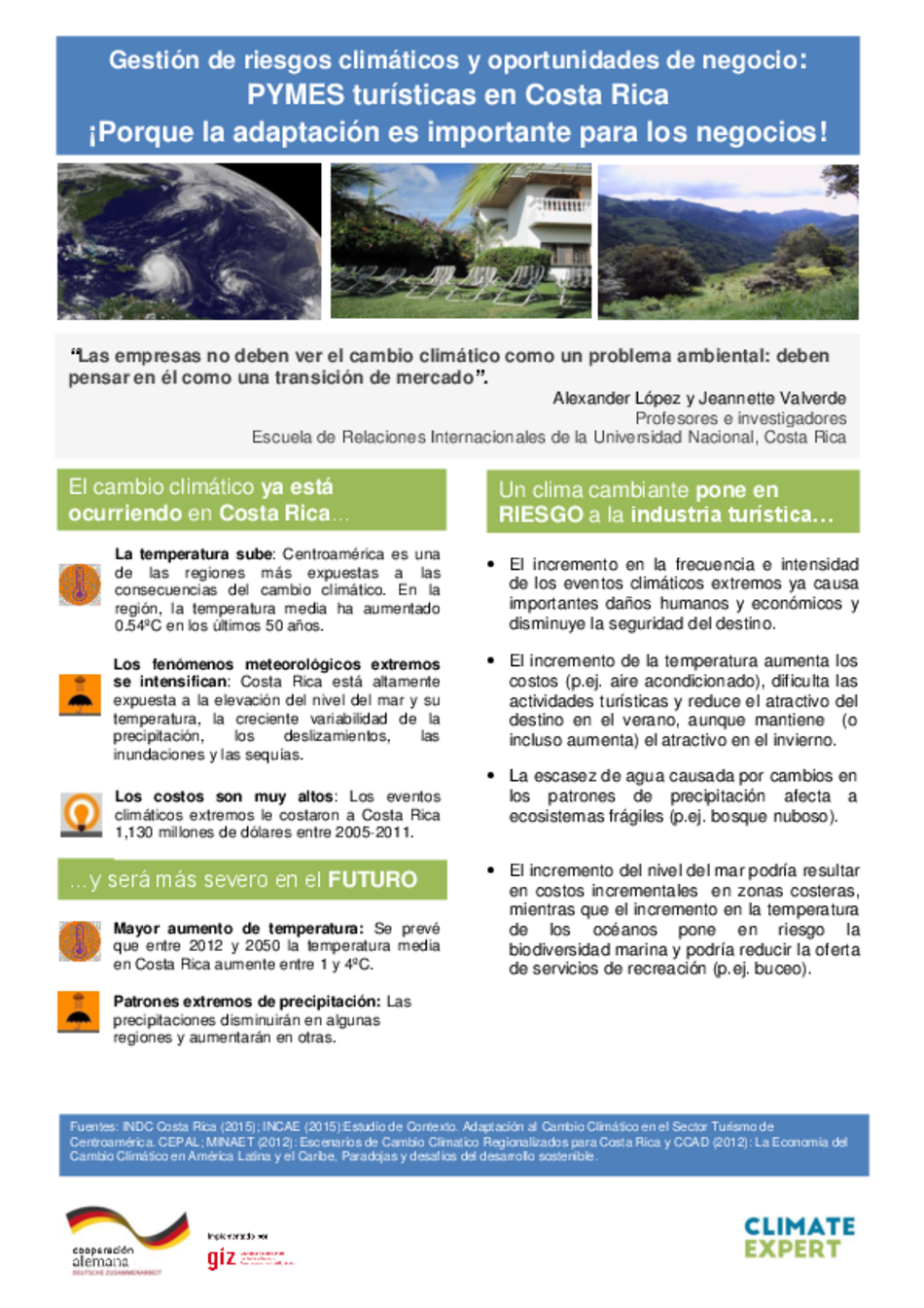Costa Rica
Costa Rica's historical socio-economic vulnerabilities are exacerbated by the countrie's location on a narrow isthmus that serves as a land bridge between two continents, surrounded by two oceanic systems, the Pacific and the Atlantic. The country is gravely affected by droughts, cyclones and the El Niño-Southern Oscillation phenomenon.
Geographic characteristics
Costa Rica is located on the Central American Isthmus and it shares a border with Nicaragua to the north and with Panama to the south. The area of Costa Rica is 51,100 km² of which 51,060 km² is land and 40 km² is water. Costa Rica´s size located between two oceans make it a highly vulnerable country to the adverse impacts of climate change. In recent years (between 2001 and 2008) floods and storms have had the highest human and economic impact in Costa Rica.Costa Rica has a tropical and subtropical climate and is part of the Neotropic ecozone. Costa Rica's dry season in most places is from December to April, while the rainy season is from May to November. On the Caribbean coast, however, December is by far the wettest month. The highlands areas are always cooler. The lowest elevation levels in the country are on the western and eastern coasts, at sea level. The highest point is Cerro Chirripó, a volcanic mountain with an elevation of 3,810 m (12,500 ft) (part of Chirripó National Park).

Costa Rican economy
Costa Rica's GDP per capita has tripled since 1960 and its growth averaged 4.5 percent between 2000 and 2013, as compared to the LAC average of 3.8 percent for the same period.With an annual GDP of $29 billion, the country's 4.5 million people enjoy the highest standard of living in Central America, with a per capita income of about US $10,569.Costa Rica experienced a remarkable shift from an agricultural country towards an industrial country. The most important sectors are the industry, tourism, renewable energies and services. Costa Rica is known worldwide for its conservation efforts and is a hot spot for eco-tourism.
Socio-economic factors
The combination of political stability, the social compact and steady growth, has resulted in one of the lowest poverty rates in Latin America and the Caribbean (LAC). Using the poverty and extreme poverty lines of US$4 per day and US$2.5 per day respectively, just 12 percent of the Costa Rican population is considered poor, and 4.7 percent extremely poor (about one third of the LAC average) (Worldbank). The country's success over the past decades is also reflected in its strong human development indicators, which continue to rank higher than those of other countries in the region.The biodiversity is one of the driving forces in the development of national socioeconomic factors. Moreno (2011) states that the national parks and reserves offer important economic sources like ecotourism, the generation of water power and the generation of working places. Andam et al. (2010) emphasizes that the protected areas contribute to income generation and poverty alleviation.The combination of geographic variations and economic factors implies high vulnerability to extreme climate events and natural hazards for Costa Rica. Part of this vulnerability has to do with the presence of populations in areas prone to volcanic eruptions and in unstable lands, degraded by wide-spread cattle ranching, or in poorly planned settlements prone to landslides and flooding (Worldbank). Therefore it is undoubtable that the loss of the biodiversity will bring negative effects on the Costa Rican economy. It is necessary to find ways to adapt to the ongoing process of climate change. On the other hand, climate change as well can bring new opportunities for business in Costa Rica.
Expected climate change in Costa Rica
The Intergovernmental Panel on Climate Change identified Costa Rica as one of the hotspots where weather conditions will change the country's current landscape in the next 50 years. According to National Meteorological Institute (IMN) projections, temperatures by 2070 will increase 3-6 degrees Celsius compared to average temperatures recorded between 1961-1990. The National Meteorological Institute recently announced that additional severe weather is in store for Costa Rica in coming months, caused by the ongoing effects of El Niño, which has yet to reach its peak in the country. Changes in rainfall patterns and levels and spikes in temperatures are indeed linked to El Niño, which is responsible for extreme weather conditions that cause both floods and drought (IMN meteorologist Luis Fernando Alvarado).The northwestern province of Guanacaste already has registered the highest deficit in rainfall since the IMN began keeping records in 1937.
What does that mean for my business?
| Expected Climate phenomena | Possible impacts on businesses |
|---|---|
| Changes in precipitation (unpredictability) | Drought in Guanacaste |
| Negatively affect crop yields and quality; e.g. drying out of seedlings | |
| Changes in temperature | Negatively affect crop yields and quality |
| Risk of new parasites and pests | |
| Heat can lead to lower productivity of workers | |
| Extinction of animal species | |
| Redistribution of species in the highlands | |
| Loss of nebula in Monteverde and therefore less attractiveness of Monteverde as hot spot tourism destination | |
| Spread of tropical diseases | |
| Cancelation of tours due to unpredictable and uncomfortable climate conditions (e.g. extreme temperatures in the Caribbean) | |
| Heavy rainfalls | Landslides that block roads and lead to shortages in production inputs, workers not reaching the company and transport interruption of finished products to clients. |
| Flooding of company premises which may lead the production to stop or destroy machines and stock. | |
| Electricity infrastructure can be damaged and result in power outages. |
The Country at a Glance
| Population: | 4.758 (2014) |
| Total Area: | 51,100 km2 |
| Capital: | San José |
| Urbanization rate: | 2,06% |
| GDP: | 49,55 billion (2014) |
| GDP-Growth: | 7.0% (2014) |
| Inflation: | 1.3% (2014) |
REFERENCES AND FURTHER INFORMATION





